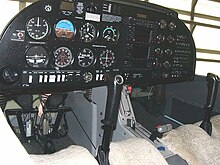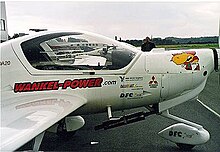Diamond DA20 Katana
| DA20/DV20 Katana | |
|---|---|

| |
| Flying Colors Precision Flight Team (DA20-A1-K100 Katana) | |
| Role | Two-seat light aircraft |
| National origin | Austria (DV20) Canada (DA20) |
| Manufacturer | Diamond Aircraft |
| First flight | 1991 |
| Introduction | 1992 |
| Produced | 1994–present |
| Developed from | Diamond HK36 Super Dimona |
| Developed into | Diamond DA40 |




The Diamond DV20/DA20 Katana is an Austrian-designed two-seat tricycle gear general aviation light aircraft, the type was later built in Canada as the DA20 for the North American market.
Development
The two-seat DV20 Katana was based on the Super Dimona with reduced wingspan. It was produced in Austria by HOAC (later changed its name to Diamond Aircraft). The Katana first flew in 1991 and gained certification in 1993.[1] The Katana was first shown in public at the 1993 Paris Air Show.[2]
The company built a factory in Canada to produce the DV20 which was designated the DA20. The first DA20 was the Rotax 912 powered A1 Katana produced in Canada in 1994. It was the first Diamond aircraft available for sale in North America. Production of the Continental IO-240-B3B powered C1 Evolution and Eclipse models began in 1998, also in Canada. Production of the A1 Katana is complete but the DA20-C1 is still being constructed in 2010.[3]
The DA20-A1 and C1 are both certified under CAR 523[4] in Canada and under FAR 23 in the USA. The DA20 is certified in the utility category, and it is permissible to intentionally spin it with flaps in the full up position.[5] In 2004, Diamond received Chinese certification for the DA20. Both models also hold JAA certification.[6]
Although the DA20 is available with instrumentation and avionics suitable for flight under instrument flight rules (IFR), its plastic airframe lacks lightning protection and thus does not qualify for IFR certification.[7]
Design
The Katana is a low-wing cantilever monoplane which features control sticks (as opposed to yokes), composite construction, a bubble canopy, low-mounted wing, a single fuel tank, a T-tail, and a castering nosewheel. All models have composite airframes constructed of glass- and carbon-fiber reinforced plastic.[7] The nose wheel of the DA20 is not linked to the rudder pedals and turns while taxiing are made with differential braking, with rudder steering becoming more effective as airspeed increases.[8]
The Katana possesses a higher glide ratio than many of its competitors. The glide ratio of the DA20-C1 is 11:1 and the DA20-A1 is 14:1.[9]
In November 2008 the company announced that it would be offering an Aspen Avionics glass cockpit primary flight display as an option on the DA20. Diamond indicated the Aspen PFD was easy to incorporate into the existing instrument panel design because it mounts in a standard round instrument hole. In October 2009 the company introduced the Garmin G500 glass cockpit as an option.[10]
Operational history
United States
Embry-Riddle Aeronautical University provided the Academy Flight Screening (AFS) program for the United States Air Force Academy in DA20-C1 Falcons, which were specially ordered with slightly smaller fuel tanks to save weight and primary flight instruments on the right side of the aircraft. Embry-Riddle operated a fleet of DA-20s at the Academy.[11] The AFS program was discontinued in 2007.
Doss Aviation, under contract for the United States Air Force, currently operates a fleet of DA-20s at the Pueblo Memorial Airport in the Initial Flight Training (IFT) program.[12] Potential USAF Pilots, Combat Systems Officers, and RPA pilots that do not have a private pilot's license must go through the Doss screening program and receive time in the DA20 before going on to their respective training programs.[13]
Variants

- DV20-A1 Katana
- Austrian-built development of the Diamond HK36 Super Dimona motorglider, powered by a 80 hp (60 kW) Rotax 912 and certified in 1993[14]
- DA20-100 Katana 100
- Factory refurbished and re-engined Katana for the European market. Powered by a 100 hp (75 kW) Rotax 912S. Introduced in 1999.[14]
- DA20-C1 Katana and Katana Eclipse
- Name used in marketing and some 1998 year model planes. The name "Katana" was actually painted on some planes. Powered by a 125 hp (93 kW) Continental IO-240 engine. In order to accommodate the extra 70 pounds of the IO-240, the Katana's battery was moved behind the baggage bay, to help move the empty cg aft, and the wing sweep has been changed from 1 degree aft to just 0.5 degrees back to shift the center of lift forward. Previous Katanas had simple hinged flaps — but at the higher maximum weight, more sophisticated slotted flaps were necessary to bring the stall speed to the JAR-VLA-specified 45 knots[15]
- DA20-C1 Evolution
- Stripped down C1, intended for flight schools as a trainer. No rear windows. Powered by a 125 hp (93 kW) Continental IO-240-B engine[14][15]
- DA20-C1 Eclipse
- Better equipped C1 for private use, with rear windows for better visibility. Powered by a 125 hp (93 kW) Continental IO-240-B engine Entered production in 1999.[14][15]
- DA20-C1 Falcon
- Military trainer version. Powered by a 125 hp (93 kW) Continental IO-240-B engine. Instruments moved in front of the right seat, where the student sits. This puts the stick in the student's right hand and throttle in the left, similar to fighter aircraft. Also equipped with a smaller fuel tank. Some Embry-Riddle Falcons have been sold to private owners and flight schools after being fitted with standard instrument panels and fuel tanks.[15]
Operators
Civil
The DA20 is popular with flight training schools and is also operated by private individuals.
Military
- Ecuadorian Air Force - 20 X DA20C1s (for delivery in 2012)[16]
- Polish Air Force - 5 X DA20 C-1 Eclipse[17]
Specifications (DA20-C1)
Data from DA20 webpage[18]
General characteristics
- Length: 7.16 m (23 ft 6 in)
- Wingspan: 10.87 m (35 ft 8 in)
- Height: 2.18 m (7 ft 2 in)
- Empty weight: 528 kg (1,164 lb)
- Gross weight: 800 kg (1,764 lb)
- Fuel capacity: 24 U.S. gallons (91 L; 20 imp gal)
- Powerplant: 1 × Continental IO-240-B3B four cylinder horizontally opposed piston aircraft engine, 93 kW (125 hp)
- Propellers: 2-bladed Sensenich Propeller fixed pitch
Performance
- Cruise speed: 256 km/h (159 mph, 138 kn)
- Stall speed: 83 km/h (52 mph, 45 kn)
- Range: 1,013 km (629 mi, 547 nmi) with 30 minute reserve
- Service ceiling: 4,000 m (13,120 ft)
- Rate of climb: 5.1 m/s (1,000 ft/min)
Avionics
- Garmin GNC 420W GPS/COM
- Garmin GTX 327 transponder with blind altitude encoder
- PS Engineering PM 1000 Intercom
See also
Related lists
References
- ^ "Katana gains Austrian approval". Flight International: 22. 5 May 1993.
- ^ "Austria's HOAC plans Canadian site". Flight International: 178. 14 July 1993.
- ^ Diamond Aircraft website
- ^ Transport Canada NICO website accessed 15 September 2007
- ^ "Operating Limitations". DA 20 Flight Information Manual (DA202/11 FIM). 1997-02-12. pp. 2–7.
- ^ Diamond Aircraft (December 2004). "Beijing PanAm starts commercial flight training with all glass DA40 Diamond Stars". Retrieved 3 October 2010.
- ^ a b Diamond Aircraft. "DA20-C1 Multi-mission Machine". Retrieved 2008-05-04.
- ^ "Normal Operating Procedures". DA 20-A1 Flight Information Manual (DA202/11 FIM). 1997-02-12. pp. 4–13.
- ^ "Emergency Procedures". DA 20-A1 Flight Information Manual (DA202/11 FIM). 1997-02-12. pp. 3–13.
- ^ Niles, Russ (November 2008). "DA20 With Aspen Glass". Retrieved 2008-11-08.
- ^ "Embry-Riddle Wins Contract to Train Air Force Pilots". Archived from the original on December 4, 2008. Retrieved 2008-12-16.
{{cite web}}: Unknown parameter|deadurl=ignored (|url-status=suggested) (help) - ^ "Doss Initital Flight Screening (Aircraft)". Retrieved 16 October 2010.
- ^ Welcome to Doss IFS! Retrieved 8 January 2012
- ^ a b c d e Diamond Aircraft (2009). "DIAMOND AIRCRAFT. A History..." Retrieved 2009-04-14.
- ^ a b c d Marsh, Alton K. "Diamond Eclipse - Delivery for the Air Force". Archived from the original on 2008-06-21. Retrieved 2009-04-14.
- ^ Diamond Aircraft (6 March 2012). "Ecuador Air Force accepts delivery of Diamond DA20 fleet". Retrieved 6 March 2012.
- ^ "Diamondy dla Dęblina - Lotnicza Polska". Lotniczapolska.pl. Retrieved 2013-06-23.
- ^ Diamond Aircraft. "Diamond Aircraft DA20 webpage". Retrieved 4 December 2014.
External links
- Diamond Aircraft Industries
- Greenspun, Philip, Diamond Katana (review).
- DA-20-A1 Katana (PDF) (flight manual), Diamond aircraft.
- DA20-C1 Eclipse Flight Manual
- DA20 detailed review on AVweb
